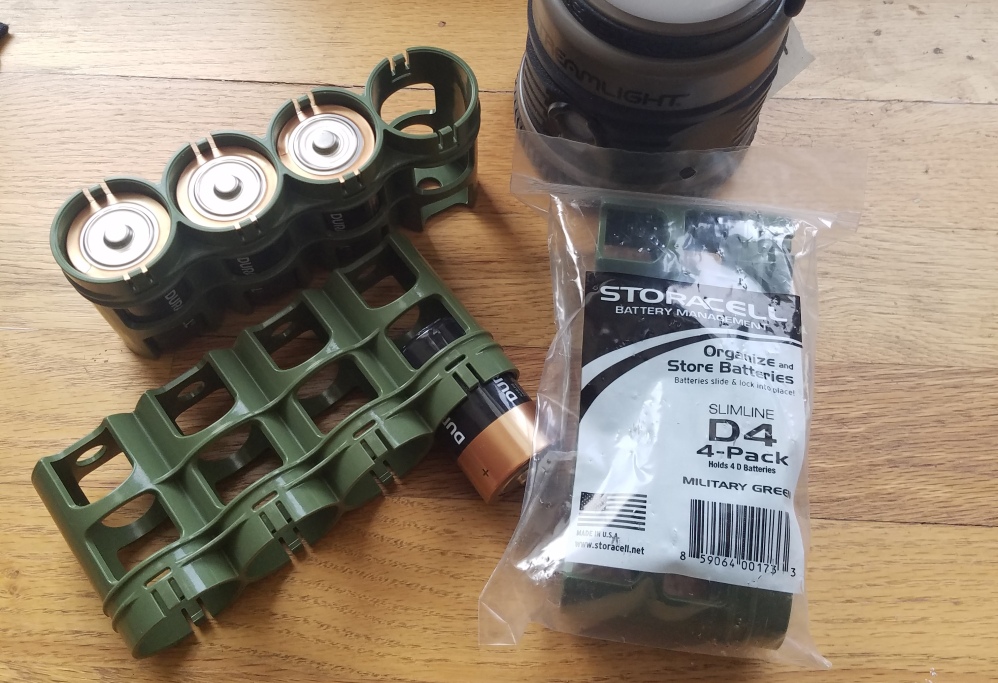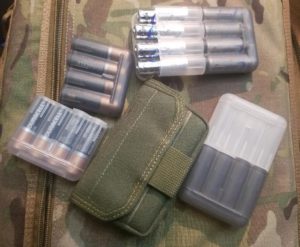There’s nothing that says you have to have battery-powered devices to help you get through the unexpected crisis, but they sure do make things easier.
When it comes to electronics, there’s a handful of things I keep in the Bag O’ Tricks ™ at all times…flashlights (plural), radio, USB charger, scanner. All of these devices run on batteries and if a crisis occurs, you are definitely going to want to have a spare reload (or three) for your devices.
You do what works for you, but here’s where I’ve landed after much thought and twenty years of practice.
First step is battery compatibility – its the BoT(tm), not a CostCo. I don’t have the room or the back muscles to carry several different battery types. I have zero interest in carrying around a handful AA batteries, 9v batteries, CR123 batteries, AAA batteries, and a couple coin batteries. Try to get all your gear singing from the same battery songbook. This is where your first value judgement, and possibly compromise, is going to have to take place. Let’s say your radios take AA but your flashlight takes CR123. You’ve got three choices at this point:
- Swap out the flashlight for one that takes AA
- Swap out the radio for one that takes CR123
- Carry two different types of batteries
It is entirely possible that, given three ‘Tier One’ pieces of gear, one of them might have to be swapped out for second tier in order to provide battery compatibility. How much are you willing to ‘step down’ in terms of utility in exchange for those streamlined logistics? Fortunately, almost everything has a functional, reliable, usable, quality alternative. Maybe you’re ‘perfect’ flashlight runs on CR123 but you need one that runs on AA…but you hate giving up all the awesome features of that particular CR123 flashlight. Well, look around, there is almost certainly an equivalent one out there that runs on AA.
And, just to be clear, I’m not advocating one type of battery over another. I’m just saying whatever battery you choose, try to stick with all your devices running off that one.
For my BoT(tm), I try to keep stuff as small as possible. Most small devices run on AA (or AAA) batteries and thats what I’ve decided to standardize on for my Bag O’ Tricks(tm). That doesnt mean my other gear doesn’t use other batteries…it just means that everything in my bag, which may be all I have in terms of resupply for the immediate time being, runs off the same battery – AA.
The battery devices I keep in my bag are pretty straightforward: AM/FM pocket radio with earphones, Icom R6 scanner (uses same headphones as AM/FM radio), a couple flashlights, and a USB charger.
The only exception to the ‘one battery’ rule is that sometimes I’ll have a rechargeable device (cell phone, flashlight) that can be recharged through USB. For those, I have a USB charger in my bag that runs off of…you guessed it…AA batteries.
I carry 16 AA batteries in a pair of Maxpedition battery pouches. There are other battery cases on Amazon and you’ll find no shortage of variations on this theme. I came into the Maxpedition ones years ago and never bothered looking for others. The plastic case is available from plenty of other makers, but the cordura pouch from Maxpedition does a nice job of keeping things handy and muffling any rattle. The most important thing is to get a case or carrier that completely isolates the battery from everything else around it and protects the contacts.
Don’t just think you can wrap your batteries with some tape over the contacts, throw them in your bag, and be fine. Bad juju, man. Same for sticking them in a cigar tube, or a cut length of PVC with duct tape over the ends. Your electronics (radio, light, gps, phone, etc.) are all critical pieces of gear. Don’t half-ass it by throwing your batteries in a bag where theyre going to short circuit against each other and be useless to you when you finally need them…assuming they don’t set your bag on fire first.
As for batteries themselves, we all know that at some point the batteries crap the bed and turn your gear into junk. I go with lithium AA batts. They are way more expensive than regular AA’s but a) they leak far far less than regular AA’s, and b) they don’t weaken over time or in temperature extremes the way regular AA’s do. Yup, theyre more expensive…but when I’m navigating my way out of the basement of a building during a blackout I will absolutely not care that they cost several times what the regular batteries cost…I’ll just be relieved they work and didnt puke in my flashlight.
And, by the way, when it comes to flashlights is there any reason not to have them use LED’s? They sip battery power and are far less delicate than the old krypton bulb lights. All my flashlights, except for legacy stuff, are LED these days. And for situations where you want to use batteries sparingly they are absolutely the better choice.
And although it isnt technically a battery, I always carry a USB plug in and one of those octopus-like multi-adaptor USB charging cables. This way, if there’s electricity, I can charge whatever USB device I or someone with me has. This really shines when traveling and need to charge up my phone at the airport so I can screw around on the internet while awaiting my flight.
I like to think that any crisis I get into where I have to rely on what’s in my BoT(tm) will be a short term one and that I’ll be back at my base of operations shortly. But life has a way of throwing curveballs and if I’m stuck living out of my bag, so to speak, for a couple days I have no doubt there will be at least one or two battery changes for some of my gear…so, I carry two 8-packs of AA lithium batteries.
There you go. A glance into the reasoning about whats in the BoT(tm) and why.




